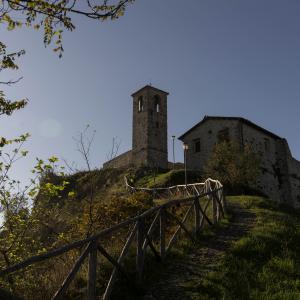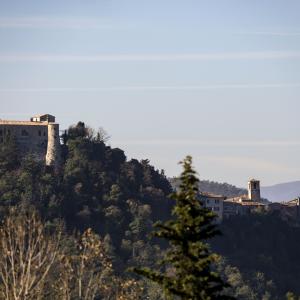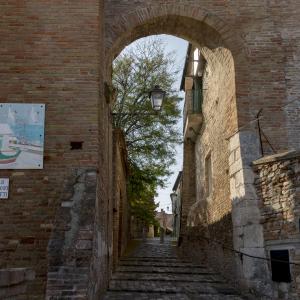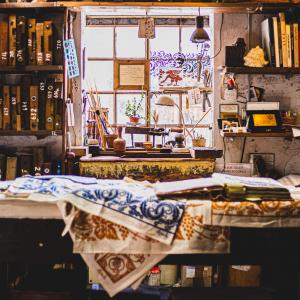From Santarcangelo to Montebello, between art, history and nature
The Valmarecchia area is a never-ending discovery: an exploration of the traditions of Emilia Romagna, not forgetting the typical cuisine, as you enjoy tales from ancient history in a luxuriant natural setting. Fine wines, fresh local produce, hills overlooking the sea, ancient fortresses, mills, craft shops and rural churches are just some of the ingredients you’ll encounter on this tour. Join us and discover it all on this 48-hour itinerary!
We start from Santarcangelo, heading up into the hills of Montebello and the lower-lying rocky outcrops that are certainly the most distinctive feature of this landscape.
This is the land of great wines: Trebbiano, Sangiovese, Pagadebit and Cagnina. It’s also the land of the famous Romagna pasta, a staple ingredient in much of the local cuisine.
1st leg
Our first stop is Santarcangelo, a “slow city” and the cradle of dialect poetry. The town’s historic center testifies to the wealth of culture that has developed here over the centuries. Walking through its streets, you get a real feeling for the traditions of Romagna. There are many things to see.
We start with the caves which run beneath the length of the historic center and extend into the “contrade” as far as the clock tower. The next things to discover include the ancient gateways to the fortified village (Campanone and Cervese), the little squares (Piazza delle Monache is a particular highlight) and the castle, the Rocca Malatestiana.
The fortress was transformed into a noble residence following a series of alterations, and is now owned by Princess Colonna. You can head back towards the town from the fortress and visit the Church of the Collegiata in Piazza Balacchi.
As you descend towards the main square and the triumphal arch dedicated to Pope Ganganelli (Clement XIV), who was born in Santarcangelo, you come to the famous Marchi printing house, where home accessories and kitchen linens are still made today using the old “rust printing” technique.
Heading towards the train station, you will come to the Ethnographic Museum, which houses a large collection of artifacts typical of the farming and folk traditions of Romagna.
Outside the town, another place worth visiting is the Byzantine church of San Michele Arcangelo. This 6th-century building is considered the oldest church in Rimini, and still has a thriving congregation today.
2nd leg
From Santarcangelo, we move on to Poggio Berni, once the stronghold of the Berni family from Rimini, but like everywhere else in this area, it is also closely linked to the House of Malatesta. In this part of the countryside, there were several fortified farms formerly called "Tombs": the beautiful complex of one of these farms is still visible today and corresponds to the current Palazzo Marcosanti which bears some evident signs of the Malatesta era. Also interesting in this area is the path of the ancient mills.
This part of the town was once the site of a number of fortified farms. The remains of one of them can still be seen today, on the site of Palazzo Marcosanti, which still bears some of the hallmarks of the Malatesta era. One of the curiosities in this area is the old windmill trail, which starts at the Sapignoli mill, also home to a museum that tells of the hard work and ingenuity involved in milling, and illustrates the network of mills in Valmarecchia.
From Poggio Berni you quickly go up to Torriana, the ancient Scorticata.
3rd leg
Torriana still has traces of the old fortifications and two large rock-cut towers perched above the town, offering a great view across the entire Valmarecchia area.
From Torriana there is a single road leading to Montebello, a perfectly preserved medieval village with a magnificent fortress, which is an amalgamation of buildings erected in different periods of history that now form a single complex, open to the public. This was also a Malatestian property, but in 1463 it was given as a fief to the Guidi di Bagno family, who still own the castle today.
Enter the castle to learn about the ghost of ‘Azzurrina’, then go outside to enjoy a panoramic view across the Valmarecchia as far as the mountains and the Montefeltro region.
4th leg
Finally, there’s a half-day trek on a medium-difficulty trail; but the scenery is stunning. The departure point is Ponte Verucchio, from where you head to the Sanctuary of Madonna di Saiano, the spiritual home of the Valmarecchia. Inside the church are some beautiful 16th-century frescoes.
Looking at the view from the top of the hill, you really do feel like you are at the top of the world. Beneath you is the Marecchia river and the splendid sights of the valley.
The only thing interrupting the silence of this extraordinary panorama is the sound of the wind. A favourite with walkers, this is also a great destination for climbing enthusiasts and cyclists. You can also reach this spot on horseback. This is a great place to come at any time of year, although the colours of nature in spring and autumn are spectacular.



